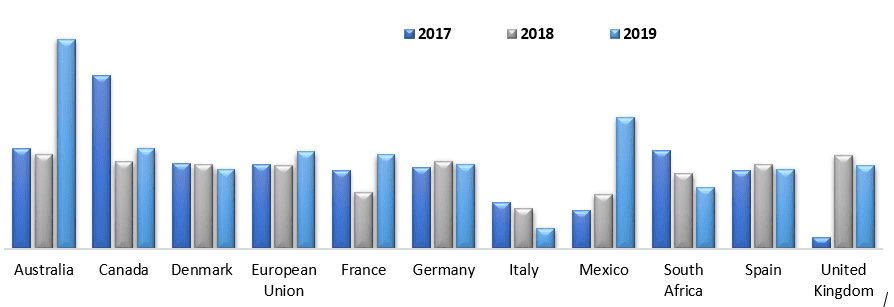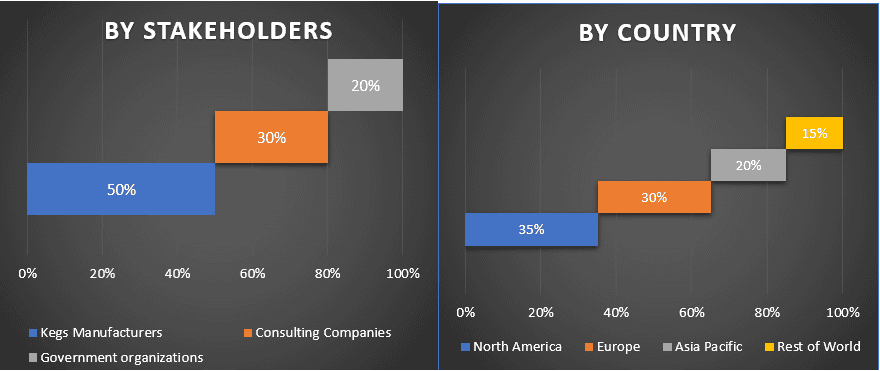
글로벌 케그 시장은 예측 기간(2021-2027) 동안 약 5%의 높은 연평균 성장률(CAGR)을 보일 것으로 예상됨
전 세계적으로 빠르게 증가하는 인구와 가처분 소득의 증가는 다양한 종류의 음료 소비 증가로 이어지고 있으며 케그에 대한 수요도 창출하고 있습니다. 모든 종류의 음료 중에서 알코올 음료는 전 세계적으로 사람들이 소비하는 두 번째로 흔한 음료 중 하나입니다. 또한 제품의 쉬운 가용성과 관광 산업의 급증으로 인해 알코올 음료, 청량 음료, 주스 등에 대한 수요도 증가하고 있습니다.
또한 부적절한 음식 섭취로 인한 영양소 부족에 대한 소비자 인식이 높아지고 영양실조로 고통받는 사람들의 수가 증가함에 따라 주스, 에너지 음료 등과 같은 무알코올 음료에 대한 수요가 늘어나면서 케그에 대한 수요 증가로 이어지고 있습니다. Oregon State University의 연구에 따르면 미국 인구(1세 이상)의 약 75%가 권장 과일 섭취량을 충족하지 못하고 80% 이상이 권장 야채 섭취량을 충족하지 못합니다. 또한 미국 인구의 거의 10%가 영양 결핍을 겪고 있으며 이로 인해 케그에 대한 수요가 증가하고 있습니다.
게다가, 늘어나는 식용유 소비 또한 전 세계적으로 케그에 대한 수요를 촉진하고 있습니다. 인도 대두 가공 협회에 따르면 대두의 전 세계 생산량은 2019-2020년에 5,836만 톤에 달했습니다. 더욱이 생산량은 2021-2022년까지 6,224만 톤에 이를 것으로 예상됩니다. 중국은 2019-2020년에 1,639만 톤으로 가장 큰 생산국입니다. 높은 발연점, 심장 건강에 좋은 지방 풍부, 뼈 건강 지원, 오메가-3 지방산 함유, 피부 건강 증진 등 대두유 사용의 이점에 대한 인식이 높아지면서 수요 증가에 대한 성장 촉매제 역할을 하고 있습니다.
가구 가처분 소득 순 증가율(%), 주요 국가별, 2017 – 2019

Ardagh Group S.A, Petainer UK Holdings Ltd., Blefa GmbH, Schaefer Container, Systems, The Metal Drum Company, Julius Kleemann GmbH & Co KG, THIELMANN – The Container Company, American Keg Company, NDL Keg Inc., Shinhan Industrial Co, Ltd 등은 케그 시장에서 활동하는 주요 업체 중 일부입니다. 이러한 업체들은 고객에게 첨단 혁신적인 제품을 제공하기 위해 여러 M&A 및 파트너십을 체결했습니다.
보고서에 제시된 통찰력
"재료 유형 중 스테인리스 스틸 부문이 주요 점유율을 차지합니다."
재료를 기준으로 시장은 플라스틱, 주석 및 스테인리스 스틸로 세분화됩니다. 스테인리스 스틸 부문은 주요 시장 점유율을 확보하고 2020년에 시장을 지배했습니다. 또한 이 부문의 시장은 2027년까지 미화 XX백만 달러에 이를 것입니다. 스테인리스 스틸 케그에 대한 수요는 알코올 및 무알코올 맥주에 대한 소비자 선호도가 높아지면서 증가하고 있습니다. 또한 스테인리스 스틸 재질로 된 소형 크기, 다양한 디자인의 케그를 사용할 수 있다는 점이 시장 성장을 주도하고 있습니다.
"용량 중 20-40리터 부문이 상당한 시장 점유율을 차지할 것입니다."
용량을 기준으로 시장은 최대 20리터, 20리터 ~ 40리터, 40리터 ~ 60리터 및 60리터 이상으로 세분화됩니다. 20리터 ~ 40리터 부문은 2020년에 XX%의 시장 점유율을 확보했습니다. 또한 이 부문의 시장은 전 세계적으로 양조장, 바 및 카페의 수가 증가함에 따라 2027년까지 미화 XX백만 달러에 이를 것입니다. 2022년 1월 현재 미국에는 62,647개의 바 및 나이트클럽 사업체가 있습니다. 그러나 최대 2리터 부문은 밀레니얼 세대 사이에서 집에서 바를 설치하는 트렌드로 인해 향후 몇 년 동안 상당한 연평균 성장률(CAGR)을 보일 것입니다.
"유통 채널 중 슈퍼마켓/대형마트 부문이 상당한 시장 점유율을 차지할 것입니다."
유통 채널을 기준으로 시장은 슈퍼마켓/대형마트, 상업용 주류 판매점 및 기타로 세분화됩니다. 대형마트/슈퍼마켓 부문은 2020년에 XX%의 시장 점유율을 확보하고 미화 XX백만 달러의 시장을 차지했습니다. 그러나 상업용 주류 판매점 부문은 향후 몇 년 동안 강력한 연평균 성장률(CAGR)을 보일 것입니다.
"최종 사용자 중 알코올 음료 부문이 상당한 시장 점유율을 차지할 것입니다."
최종 사용자를 기준으로 시장은 알코올 음료, 무알코올 음료, 식용유, 화학 제품 및 기타로 세분화됩니다. 알코올 음료 부문은 주요 시장 점유율을 확보하고 2020년에 시장을 지배했습니다. 또한 이 부문의 시장은 2027년까지 미화 XX백만 달러에 이를 것입니다.
"유럽은 케그 시장의 가장 큰 시장 중 하나입니다."
케그 시장의 시장 역학을 더 잘 이해하기 위해 북미, 유럽, 아시아 태평양 및 기타 지역을 포함하여 전 세계 여러 지역에 대한 자세한 분석이 수행되었습니다. 유럽은 가처분 소득 증가와 알코올 음료 소비 증가로 인해 2020년에 시장을 지배하고 선도적인 수익 점유율을 창출했습니다. 또한 케그 공급업체의 풍부한 가용성은 시장 성장에 대한 성장 촉매제 역할을 하고 있습니다.
이 보고서를 구매해야 하는 이유:
- 이 연구에는 인증된 주요 업계 전문가가 검증한 시장 규모 및 예측 분석이 포함되어 있습니다.
- 이 보고서는 전체 산업 성과에 대한 빠른 검토를 한눈에 제공합니다.
- 이 보고서는 주요 비즈니스 재무, 제품 포트폴리오, 확장 전략 및 최근 개발에 중점을 두고 주요 업계 동료에 대한 심층 분석을 다룹니다.
- 업계에 널리 퍼져있는 동인, 제약, 주요 트렌드 및 기회에 대한 자세한 조사
- 이 연구는 여러 부문에 걸쳐 시장을 포괄적으로 다룹니다.
- 산업에 대한 심층적 인 지역 수준 분석
맞춤 옵션:
케그 시장은 요구 사항 또는 기타 시장 부문에 따라 추가로 맞춤화할 수 있습니다. 이 외에도 UMI는 귀하가 자체 비즈니스 요구 사항을 가질 수 있음을 이해하므로 귀하의 요구 사항에 완전히 맞는 보고서를 얻으려면 언제든지 저희에게 연락하십시오.
목차
Kegs 시장의 역사적 시장 분석, 현재 시장 추정, 미래 시장 예측은 주요 지역에서 Kegs에 대한 수요를 창출하고 분석하기 위해 수행된 세 가지 주요 단계였습니다. 역사적 시장 수치를 수집하고 현재 시장 규모를 추정하기 위해 광범위한 2차 조사가 수행되었습니다. 둘째, 이러한 통찰력을 검증하기 위해 수많은 결과와 가정이 고려되었습니다. 또한 Kegs 시장의 가치 사슬 전반에 걸쳐 업계 전문가와 함께 광범위한 1차 인터뷰도 수행되었습니다. 1차 인터뷰를 통해 시장 수치를 가정하고 검증한 후, 우리는 전체 시장 규모를 예측하기 위해 상향식/하향식 접근 방식을 사용했습니다. 이후 시장 세분화 및 데이터 삼각 측량 방법을 채택하여 업계 관련 세그먼트 및 하위 세그먼트의 시장 규모를 추정하고 분석했습니다. 자세한 방법론은 아래에 설명되어 있습니다.
역사적 시장 규모 분석
1단계: 2차 출처에 대한 심층 연구:
연례 보고서 및 재무 제표, 실적 발표, 보도 자료 등과 같은 회사 내부 자료와 저널, 뉴스 및 기사, 정부 간행물, 경쟁사 간행물, 부문 보고서, 타사 데이터베이스 및 기타 신뢰할 수 있는 간행물을 포함한 외부 자료를 통해 Kegs의 역사적 시장 규모를 확보하기 위해 자세한 2차 연구를 수행했습니다.
2단계: 시장 세분화:
Kegs 시장의 역사적 시장 규모를 확보한 후, 주요 지역의 재료 유형, 용량, 유통 유형 및 최종 사용자에 대한 역사적 시장 통찰력과 점유율을 수집하기 위해 자세한 2차 분석을 수행했습니다. 보고서에 포함된 주요 세그먼트는 재료 유형과 용량입니다. 전 세계적으로 Kegs의 전체 채택률을 평가하기 위해 추가 지역 및 국가 수준 분석이 수행되었습니다.
3단계: 요인 분석:
다양한 세그먼트 및 하위 세그먼트의 역사적 시장 규모를 확보한 후, Kegs의 현재 시장 규모를 추정하기 위해 자세한 요인 분석을 수행했습니다. 또한 가처분 소득 증가, 주류 소비 급증 등과 같은 종속 변수와 독립 변수를 사용하여 요인 분석을 수행했습니다. 전 세계 Kegs 산업에서 최고의 파트너십, 합병 및 인수, 사업 확장 및 제품 출시를 고려하여 수요 및 공급측 시나리오에 대한 철저한 분석이 수행되었습니다.
현재 시장 규모 추정 및 예측
현재 시장 규모 측정: 위 3단계의 실행 가능한 통찰력을 바탕으로 현재 시장 규모, Kegs 시장의 주요 업체 및 세그먼트의 시장 점유율에 도달했습니다. 필요한 모든 백분율 점유율 분할 및 시장 세분화는 위에서 언급한 2차 접근 방식을 사용하여 결정되었으며 1차 인터뷰를 통해 확인되었습니다.
추정 및 예측: 시장 추정 및 예측을 위해 이해 관계자에게 제공되는 동인 및 추세, 제약 및 기회를 포함한 다양한 요인에 가중치가 부여되었습니다. 이러한 요인을 분석한 후 관련 예측 기술, 즉 상향식/하향식 접근 방식을 적용하여 전 세계 주요 시장에서 다양한 세그먼트 및 하위 세그먼트에 대해 약 2027년의 시장 예측에 도달했습니다. 시장 규모를 추정하기 위해 채택된 연구 방법론은 다음을 포함합니다.
- 가치(US$) 측면에서 산업의 시장 규모와 주요 시장에서 Kegs의 국내 채택률
- 시장 세그먼트 및 하위 세그먼트의 모든 백분율 점유율, 분할 및 세분화
- 제공되는 서비스 측면에서 Kegs 시장의 주요 업체. 또한 빠르게 성장하는 시장에서 경쟁하기 위해 이러한 업체가 채택한 성장 전략
시장 규모 및 점유율 검증
1차 조사: 주요 지역에서 최고 경영진(CXO/VP, 영업 책임자, 마케팅 책임자, 운영 책임자, 지역 책임자, 국가 책임자 등)을 포함한 핵심 오피니언 리더(KOL)와 심층 인터뷰를 실시했습니다. 그런 다음 1차 조사 결과를 요약하고 명시된 가설을 증명하기 위해 통계 분석을 수행했습니다. 1차 조사에서 얻은 정보를 2차 조사 결과와 통합하여 정보를 실행 가능한 통찰력으로 전환했습니다.
다양한 지역의 1차 참가자 분할

시장 엔지니어링
Kegs 시장의 각 세그먼트 및 하위 세그먼트의 정확한 통계 수치에 도달하고 전체 시장 추정을 완료하기 위해 데이터 삼각 측량 기술을 사용했습니다. 재료 유형, 용량, 유통 채널 및 Kegs 시장의 최종 사용자 영역에서 다양한 매개변수와 추세를 연구한 후 데이터를 여러 세그먼트 하위 세그먼트로 분할했습니다.
Kegs 시장 조사의 주요 목표
Kegs의 현재 및 미래 시장 동향이 연구에서 정확히 지적되었습니다. 투자자는 연구에서 수행된 질적 및 양적 분석을 통해 투자를 위한 재량의 근거가 되는 전략적 통찰력을 얻을 수 있습니다. 현재 및 미래 시장 동향은 지역 수준에서 시장의 전반적인 매력도를 결정하여 산업 참가자가 미개척 시장을 활용하여 선점자 이점으로 이익을 얻을 수 있는 플랫폼을 제공했습니다. 연구의 다른 양적 목표는 다음과 같습니다.
- 가치(US$) 측면에서 Kegs의 현재 및 예측 시장 규모를 분석합니다. 또한 다양한 세그먼트 및 하위 세그먼트의 현재 및 예측 시장 규모를 분석합니다.
- 연구의 세그먼트에는 재료 유형, 용량, 유통 채널 및 최종 사용자 영역이 포함됩니다.
- Kegs 산업에 대한 규제 프레임워크를 정의하고 분석합니다.
- 다양한 중개인의 존재와 관련된 가치 사슬을 분석하고 업계의 고객 및 경쟁사 행동을 분석합니다.
- 주요 국가의 Kegs 시장에 대한 현재 및 예측 시장 규모를 분석합니다.
- 보고서에서 연구된 주요 지역에는 북미, 유럽, 아시아 태평양 및 기타 지역이 포함됩니다.
- Kegs 시장의 회사 프로필과 빠르게 성장하는 시장에서 지속하기 위해 시장 참가자가 채택한 성장 전략
- 업계에 대한 심층적인 지역 수준 분석
관련 보고서
이 상품을 구매한 고객님들도 함께 구매하신 상품










